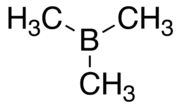Trimethylborane
 | |||
| |||
| Names | |||
|---|---|---|---|
| IUPAC name
Trimethylborane | |||
| Other names
trimethylborine, trimethylboron | |||
| Identifiers | |||
| 593-90-8 | |||
| 3D model (Jmol) | Interactive image | ||
| ChemSpider | 62201 | ||
| ECHA InfoCard | 100.008.926 | ||
| EC Number | 209-816-3 | ||
| |||
| |||
| Properties | |||
| C3H9B | |||
| Molar mass | 55.92 g/mol | ||
| Appearance | Colorless gas or liquid | ||
| Density | 0.625 g/cm3 at -100 °C[1] | ||
| Melting point | −161.5 °C (−258.7 °F; 111.6 K) | ||
| Boiling point | −20.2 °C (−4.4 °F; 253.0 K) | ||
| slight, Highly reactive | |||
| Structure | |||
| Δ | |||
| Hazards | |||
| Main hazards | Spontaneously flammable in air; causes burns | ||
| R-phrases | R17 R34[2] | ||
| S-phrases | S7 S23 S26 S36/37/39 S43 S45[2] | ||
| −40 °C (−40 °F; 233 K)[2] | |||
| Related compounds | |||
| Related compounds |
triethylborane Diborane methylborane | ||
| Except where otherwise noted, data are given for materials in their standard state (at 25 °C [77 °F], 100 kPa). | |||
| | |||
| Infobox references | |||
Trimethylborane (TMB) is a toxic, pyrophoric gas with the formula B(CH3)3 (which can also be written as Me3B, with Me representing methyl). Its melting point is -161.5 °C and its boiling point is -20.2 °C. Vapour pressure is given by log P = 6.1385+1.75 log T - 1393.3/T - 0.007735 T. T is temperature in Kelvin.[3] CAS number is 593-90-8.[4] Molecular weight is 55.914. The heat of vapourisation is 25.6 kJ/mol.[2]
Properties
As a liquid it is colourless. The strongest line in the infrared spectrum is at 1330 cm−1 followed by lines at 3010 cm−1 and 1185 cm−1.
Preparation
Trimethylborane was first made by Stock and Zeidler. Their method of preparation combined boron trichloride gas with dimethylzinc.[3] Although the substance can be prepared using Grignard reagents the output is contaminated by unwanted products from the solvent. Trimethylborane can be made on a small scale with a 98% yield by reacting trimethylaluminium in hexane with boron tribromide in dibutyl ether as a solvent.[3] Yet other methods are reacting tributyl borate with trimethylaluminium chloride, or potassium tetrafluoroborate with trimethylaluminium.[5] Yet another method is to add boron trifluoride in ether to methyl magnesium iodide.[6]
Reactions
Trimethylborane spontaneously ignites in air if the concentration is high enough. It burns with a green flame producing soot.[7] Slower oxidation with oxygen in a solvent or in the gas phase can produce dimethyltrioxadiboralane, which contains a ring of two boron and three oxygen atoms. However the major product is dimethylborylmethylperoxide, which rapidly decomposes to dimethoxymethylborane.[8]
Trimethylborane is a strong Lewis acid. It reacts with water and chlorine at room temperature. It also reacts with grease but not with Teflon or glass.[3] Trimethylborane can form an adduct with ammonia: (NH3):B(CH3)3.[9]
Trimethylborane reacts with diborane to disproportionate to form monomethyldiborane and dimethyldiborane: (CH3)BH2.BH3 and (CH3)2BH.BH3.
It reacts as a gas with trimethylphosphine to form a solid Lewis salt with a heat of formation of -41 kcal per mol. This adduct has a heat of sublimation of -24.6 kcal/mol. No reaction occurs with trimethylarsine or trimethylstibine.[6]
Methyl lithium reacting with the Trimethylborane produces a tetramethylborate salt: LiB(CH3)4.[10] The tetramethylborate ion has a negative charge and is isoelectronic with neopentane, tetramethylsilane, and the tetramethylammonium cation.
Use
Trimethylborane has been used as a neutron counter. For this use it has to be very pure.[9] It is also used in chemical vapour deposition where boron and carbon need to be deposited together.
References
- ↑ http://www.voltaix.com/images/doc/Msb000_TMB.pdf MSDS from Voltaix
- 1 2 3 4 Trimethylborane
- 1 2 3 4 William S. Rees, Jr. and al (1990). Alvin P. Ginsberg, ed. Trimethylborane. Inorganic Syntheses. 27. p. 339.
- ↑ Graner, G., Hirota, E., Iijima, T., Kuchitsu, K., Ramsay, D. A., Vogt, J., Vogt, N.; Hirota; Iijima; Kuchitsu; Ramsay; Vogt; Vogt (2001). "C3H9B Trimethylborane". SpringerMaterials. Landolt-Börnstein - Group II Molecules and Radicals. 25C: 1. doi:10.1007/10688787_381. ISBN 3-540-66774-1.
- ↑ Roland Koumlstera, Paul Bingera Wilhelm, V. Dahlhof; Binger; Dahlhoff (1973). "A Convenient Preparation of Trimethylborane and Triethylborane". Synthesis and Reactivity in Inorganic and Metal-Organic Chemistry. 3 (4): 359–367. doi:10.1080/00945717308057281.
- 1 2 Donald Charles Mente (May 1975). "The Reactions of Trimethyl group Va Lewis Bases with simple Boron Lewis Acids" (PDF).
- ↑ Herbert Ellern (1968). "Military and Civilian Pyrotechnics". Chemical Publishing Company. p. 24. CiteSeerX 10.1.1.137.1104
 .
. - ↑ Barton, Lawrence; Crump, John M.; Wheatley, Jeffrey B. (June 1974). "Trioxadiborolanes from the oxidation of methyldiborane". Journal of Organometallic Chemistry. 72 (1): C1–C3. doi:10.1016/s0022-328x(00)82027-6.
- 1 2 Gaylon S. Ross; et al. (2 October 1961). "Preparation of High Purity Trimethylborane" (PDF). Journal of Research of the National Bureau of Standards Section A. 66 (1).
- ↑ Georg Wittig in 1958


